Our Peaceful Stone Age Ancestors
Scant Evidence that Prehistoric
People were Warlike,
Anthropologist claims
Anthropologist claims

by Mark Miller
The Stone Age seems to have been a time of peace and not war, says an anthropologist specializing in war who has studied the published work of dozens of researchers. Unfortunately for many millions of victims of death, wounding, displacement, hunger and loss, humanity began to make war compulsively, some groups as early as 13,000 years ago.
There was mostly peace in Europe and the Near East during a large part of the Stone Age, but war swept Europe and the Near East by the time of the late Neolithic (the most recent period of the Stone Age), and the Copper and Bronze ages beginning about the sixth to fifth millennium BC.
“In both Europe and the Near East the literature reviews begin without signs of war and end in periods when war is unambiguously established and often a dominant factor in social life,” writes R. Brian Ferguson in his chapter “The Prehistory of War and Peace in Europe and the Near East.” He contributed the chapter to the 2013 book War, Peace and Human Nature. Ferguson is a professor of anthropology at Rutgers University in New Jersey. (A profile of Ferguson and PDF files of his published works may be accessed at http://www.ncas.rutgers.edu/r-brian-ferguson.)
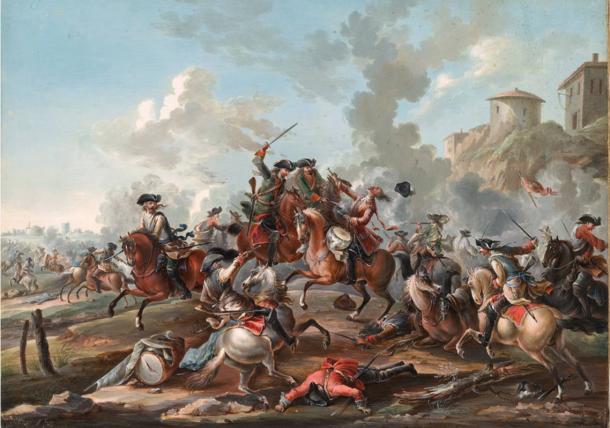
Ferguson claims war is a relatively ‘new’
development and that there is little evidence of regular wars in the Stone
Age. European Cavalry Battle Scene (Wikimedia
Commons)
“Many people, some archaeologists and most evolutionary psychologists, for example, think that war has always been practiced by humans, and may go back without break to our pre-human ancestors,” Ferguson told Ancient Origins in e-mail. “My argument is that war regularly – not always – leaves archaeological traces, if a people are known by a substantial record of skeletal remains, and/or settlement remains, sometimes supported by weapons or art. Looking at the archaeological record around the world typically shows that those signs eventually show up, but usually after a more or less long stretch when they are not present. When this appears as a recurrent pattern around the world, the straightforward explanation is that war has beginnings.”
Go back several millennia BC “and war is not evident,” he said.
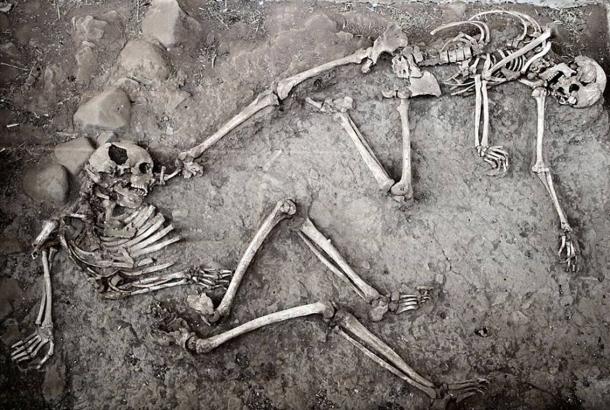
Archaeologists can find traces of war in
ancient skeletons by examining their injuries. The above picture shows two
skeletons recovered from the archaeological site of Hadyakh, ancient
Neyshapour, populated 9th-14th century AD. The brutal and
terrible end of this village can be seen through the multiples skeletons found,
all having multiple trauma and crushing lesions. (Wikimedia Commons)
"The archaeological record tells us that war began in very different times in different places, separated by many thousands of years. In central Florida, war may have been present by 5400 BC, but on the southern Great Plains skeletons are nearly trauma-free until after 800 AD. Much of the tribal universe across the Americas and the Pacific saw a great intensification of war around the 13th century AD, apparently related to climate change. If forced to answer the question: globally, when did war begin? I would have to say between 11,000 BC and 1400 AD."
Ferguson at one time reported a date for the inception of war in the Yellow River area of China. But he subsequently learned Maoist archeology ignored the possibility of early war, so he has no idea now. “Most of sub-Saharan Africa has negligible archaeological excavation, so who knows?” he said. “New Guinea: also almost no evidence, though northern Australia seems to have potentially lethal group clashes (among hunter-gatherers) as early as 4000 BC, and continuing thereafter.”
The idea that humankind in ancient times was characteristically warlike is based on preconceptions and wishful thinking, not careful examination of evidence,” he said.
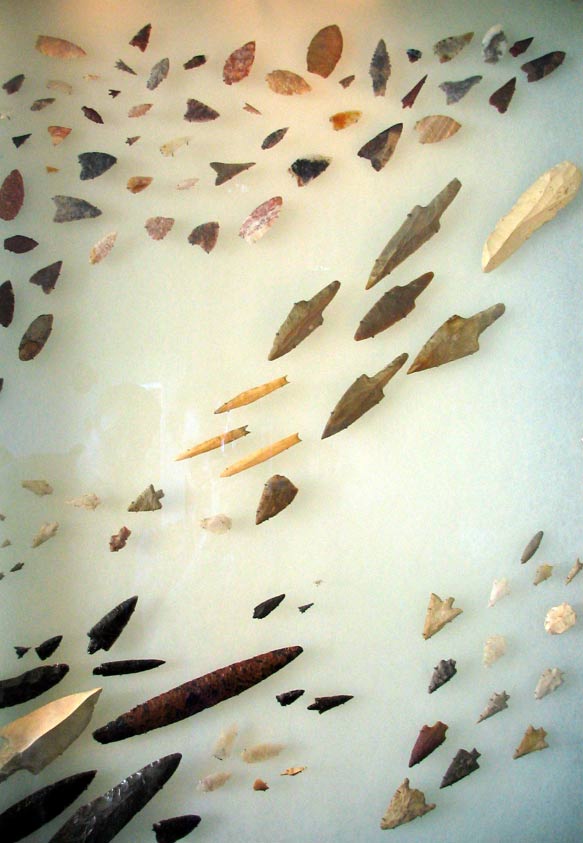
It’s impossible to say if prehistoric people
made these stone arrow- and spearheads for use on other people or on animals,
but war was rare in the Stone Age, an anthropological researcher has concluded.
(Phyzome photo/Wikimedia
Commons)
Ferguson identifies several preconditions that make war more likely but not inevitable. He names geographic concentration of critical resources, transition from nomadic to stationary life, high population densities, storage of food, domestication of livestock, long-distance trade that may be monopolized, major ecological events that reduce production of food, and political or social hierarchies and ranking. Even so, people in some places and times had all these factors present and apparently did not make war.
The presence of war in a prehistoric society may be studied by looking at prehistoric representations of combat or homicide; presence of weapons; evidence of fortifications in layers now buried in the earth; and skeletons showing wounds.
Ferguson alludes to another researcher who identifies “tool-weapons, clearly used for work but also usable for killing people; weapon-tools, probably used for fighting but possibly for work; and weapons proper, such as swords.” A presence of many tool-weapons is “a weak positive for war,” but when tool-weapons are absent it is a strong indication the people did not make war.
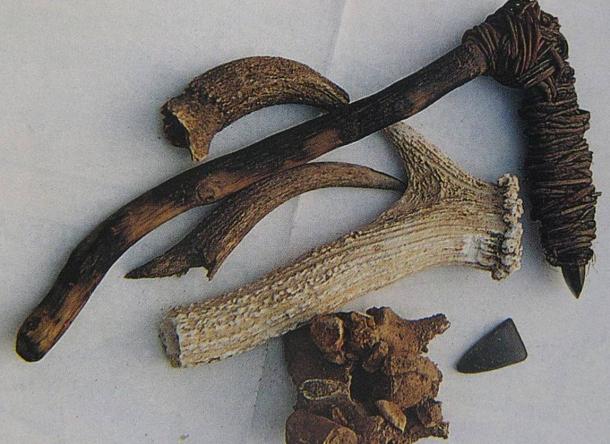
Recovery of ancient weapons helps to piece
together periods of war in prehistory (Wikimedia
Commons)
As for apparent wounds to skeletons, many of which are incomplete, Ferguson cites several researchers in Europe and the Near East who found very few among remains of prehistoric peoples. For example, a researcher examined 209 Middle and Upper Paleolithic remains, including Neanderthals, from southern France and found five fractures. That research concluded “the absence of a single parry fracture or wound to the side of the head in my sample seems to belie the previously held notions in the literature of bestial behavior and violence for this time period.” Other researchers, too, found little or no evidence of deliberately inflicted trauma in the Paleolithic, which ends around 10,000 BC.
Of the Mesolithic of 10,000 to 8,000 BC, Ferguson writes “in Europe, some Mesolithic societies made war, or may have, but others did not.”
Ferguson summarizes several studies of the skeletal remains of Mesolithic and Neolithic Europe, of the period from 10,000 to 5500 BC and finds a few people had signs of violent wounding, but these may have been inflicted by members of their own tribe and not in war. There is also some evidence of cannibalism then, as there was earlier, which he states may or may not be related to war.
By the fifth millennium BC, most of Europe passes from New Stone Age to the Copper and later Bronze ages. “By those ages, war had become a cultural obsession across Europe,” he writes.
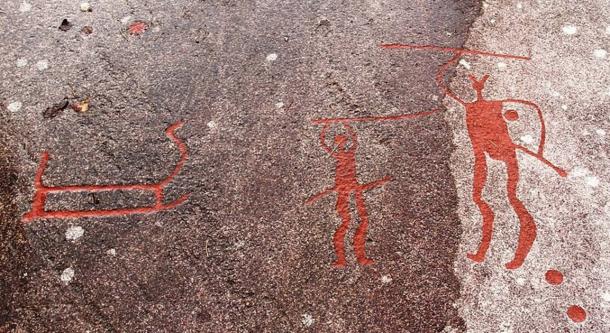
Bronze Age War: Image from Vitlycke, a bronze-age
UNESCO world heritage site in Tanumshede, western Sweden, depicts fighting with
weapons (Wikimedia
Commons)
“The sparse skeletal evidence of violent death, shifts in tools towards weapons and settlement clustering with vacant spaces between all become more common and pronounced through the Middle and into the Late and Final Neolithic,” he wrote. These periods lasted from about 5,500 BC to 2200 BC.
Ferguson looked at four regions in the Near East and found mostly evidence of peace there until, variously, in what is now northern Iraq beginning in the 10th millennium BC; in Mesopotamia in the seventh millennium; and at others sites in the northern Tigris area from 3800 to 3500 BC. In Anatolia (Turkey), there was an upsurge of war around the sixth millennium BC, he says.
Ferguson also looked at the southern Levant at the eastern end of the Mediterranean Sea and found “the most intriguing findings. From the time of the Natufians, beginning around 13,100 BC up to the early Early Bronze Age IIb around 3200 BC there are only a handful of violent deaths indicated by skeletal remains.” He lists seven wounded skeletons and says, “Nevertheless, seven instances from nearly 10,000 years with only one or two adult males is a remarkable record against the presence of war.” He said the only sites suspected of having fortifications during the period were Jericho and Beidha, and the maces found in the region appear to be ceremonial, not made for war.
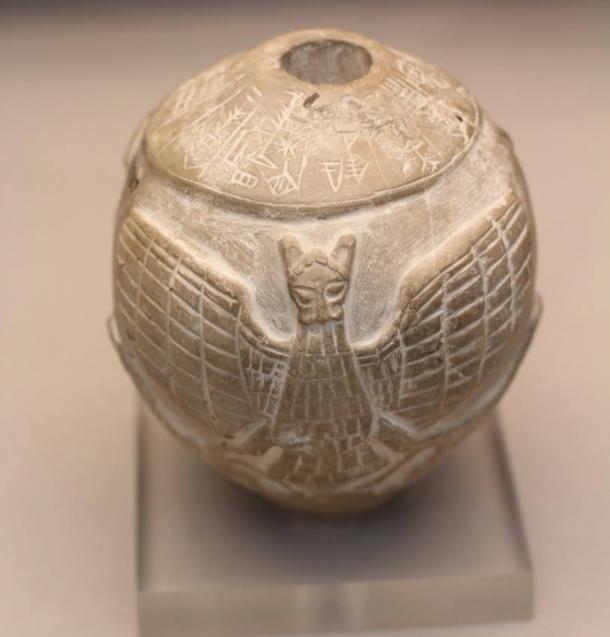
A mace head with cuneiform dedicating the
mace to the god Ningirsu, circa 2400 B.C., Mesopotamia (Photo by M0tty/Wikimedia
Commons)
While war has been a fact of life (and death) for millennia, Ferguson’s writings seem to hold a glint of hope for the human race: “My position is that human beings have no evolved predisposition to inflict deadly violence on people outside their own social group.” He wrote in an earlier work: “Even at relatively advanced levels of sociocultural evolution, there is no reason, theoretically, to deny the possibility of peaceful societies.”
Featured image: Prehistoric man in a peaceful
landscape. Credit: BigStockPhoto
From Ancient Origins @ http://www.ancient-origins.net/news-history-archaeology/scant-evidence-prehistoric-people-were-warlike-anthropologist-claims-002751
For more information about the antediluvian world see http://nexusilluminati.blogspot.com/search/label/antediluvian%20world
- Scroll down through ‘Older Posts’ at the end of each section
Hope you like this
not for profit site -
It takes hours of work every day by
a genuinely incapacitated invalid to maintain, write, edit, research,
illustrate and publish this website from a tiny cabin in a remote forest
Like what we do? Please give anything
you can -
Contribute any amount and receive at
least one New Illuminati eBook!
(You can use a card
securely if you don’t use Paypal)
Please click below -
Spare Bitcoin
change?
For further enlightening
information enter a word or phrase into the random synchronistic search box @
the top left of http://nexusilluminati.blogspot.com
And see
New Illuminati – http://nexusilluminati.blogspot.com
New Illuminati on Facebook - https://www.facebook.com/the.new.illuminati
New Illuminati Youtube Channel - http://www.youtube.com/user/newilluminati
New Illuminati on Google+ @ https://plus.google.com/115562482213600937809/posts
New Illuminati on Twitter @ www.twitter.com/new_illuminati
New Illuminations –Art(icles) by
R. Ayana @ http://newilluminations.blogspot.com
The Her(m)etic Hermit - http://hermetic.blog.com
DISGRUNTLED SITE ADMINS PLEASE NOTE –
We provide a live link to your original material on your site (and
links via social networking services) - which raises your ranking on search
engines and helps spread your info further! This site is
published under Creative Commons Fair Use Copyright (unless an individual
article or other item is declared otherwise by the copyright holder). Reproduction
for non-profit use is permitted & encouraged, - if you give attribution to the work &
author and include all links in the original (along with this or a similar
notice).
Feel free to make non-commercial hard (printed) or software copies or
mirror sites - you never know how long something will stay glued to the web –
but remember attribution!
If you like what you see, please send a donation (no amount is too
small or too large) or leave a comment – and thanks for reading this far…
Live long and prosper! Together we can create the best of all possible
worlds…
From the New Illuminati – http://nexusilluminati.blogspot.com
Wars are the result of scarcity based social systems, when things are scarce i.e. food resources, etc... We can then place a value symbol on them and when things and or symbols become more valuable then our individual and or collective lives, wars become an inevitability. If things that people required to sustain their lives from the cradle to the grave were abundant and distributed amongst the entire population, then wars were not needed during the stone ages but I assure you that if things were scarce and people were starving, then wars occurred naturally. Today we're living in a state of manufactured scarcity practices used for keeping a mythical elite in power as war becomes their device for control.... Natural abundances are the enemy of the myth makers, for peace is not a desired consideration amongst the control freaks in charge of Alice's Wonderland!
ReplyDelete